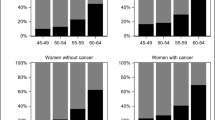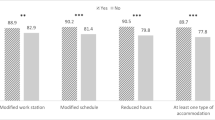Abstract
Purpose
This analysis describes the long-term workforce participation patterns of individuals diagnosed with head and neck cancer (HNC).
Methods
Survivors of HNC (ICD10 C00-C14, C32) diagnosed at least 8 months previously were identified from the National Cancer Registry Ireland and sent a survey including questions about working arrangements before and since diagnosis. Descriptive statistics and multivariate logistic regression were used to examine the factors that influence workforce participation at 0, 1 and 5 years after diagnosis.
Results
Two hundred sixty-four individuals employed at the time of diagnosis responded to the survey, an average 6 years post-diagnosis. Seventy-seven percent took time off work after diagnosis, with a mean work absence of 9 months (range 0–65 months). Fifty-two percent of participants reduced their working hours (mean reduction 15 h/week). The odds of workforce participation following HNC were increased by not being eligible for free medical care (OR 2.61, 95 % CI 1.15–5.94), having lip, mouth or salivary gland cancer (compared to cancer of the pharynx or cancer of the larynx, OR 2.79, 1.20–6.46), being self-employed (OR 2.01, 1.07–3.80), having private health insurance (OR 2.06, 1.11–3.85) and not receiving chemotherapy (OR 2.82, 1.31–6.06). After 5 years, only the effect of medical card remained (i.e., medical insurance) (OR 4.03, 1.69–9.62).
Conclusions
Workforce participation patterns after HNC are complex and are influenced by cancer, treatment and employment factors.
Implications for Cancer Survivors
Patients should be informed of the potential impacts of HNC on workforce participation, and clinicians, policy makers and employers should be aware of these potential longer-term effects and related variables.

Similar content being viewed by others
References
National Cancer Registry Ireland. Cancers of the head and neck. Cancer Trends No. 10. Cork: National Cancer Registry Ireland 2011.
Ferlay J, Steliarova-Foucher E, Lortet-Tieulent J, Rosso S, Coebergh JWW, Comber H, et al. Cancer incidence and mortality patterns in Europe: estimates for 40 countries in 2012. Eur J Cancer (Oxford, England : 1990). 2013;49:1374–403.
Adelstein DJ, Ridge JA, Gillison ML, Chaturvedi AK, D’Souza G, Gravitt PE, et al. Head and neck squamous cell cancer and the human papillomavirus: summary of a National Cancer Institute State of the Science Meeting, November 9–10, 2008, Washington, D.C. Head Neck. 2009;31(11):1393–422. doi:10.1002/hed.21269.
Coughlan D, Frick KD. Economic impact of human papillomavirus-associated head and neck cancers in the United States. Otolaryngol Clin N Am. 2012;45:899–917.
Verdonck-de Leeuw IM, van Bleek WJ, Leemans CR, de Bree R. Employment and return to work in head and neck cancer survivors. Oral Oncol. 2010;46:56–60.
Buckwalter AE, Karnell LH, Smith RB, Christensen AJ, Funk GF. Patient-reported factors associated with discontinuing employment following head and neck cancer treatment. Arch Otolaryngol Head Neck Surg. 2007;133(May):464–70.
Liu HE. Changes of satisfaction with appearance and working status for head and neck tumour patients. J Clin Nurs. 2008;17:1930–8.
Spelten ER, Sprangers MA, Verbeek JH. Factors reported to influence the return to work of cancer survivors: a literature review. Psychooncology. 2002;11(2):124–31.
Harrison LB, Zelefsky MJ, Pfister DG, Carper E, Raben A, Kraus DH, et al. Detailed quality of life assessment in patients treated with primary radiotherapy for squamous cell cancer of the base of the tongue. Head Neck. 1997;19:169–75.
Chang KP, Lai CS, Hsieh TY, Wu YC, Chang CH. Two-year quality of life after free flap reconstruction in tumor-site discrepancy among Taiwanese with moderately advanced oral squamous cell carcinoma. World J Surg Oncol. 2012;10:145.
Ramirez MJF, Ferriol EE, Domenech FG, Llatas MC, Suarez-Varela MM, Martinez RL. Psychosocial adjustment in patients surgically treated for laryngeal cancer. Otolaryngol Head Neck Surg. 2003;129:92–7. Psychosocial adjustment in patients surgically treated for laryngeal cancer.
Taylor JC, Terrell JE, Ronis DL, Fowler KE, Bishop C, Lambert MT, et al. Disability in patients with head and neck cancer. Arch Otolaryngol Head Neck Surg. 2004;130:764–9.
Feuerstein M, Todd BL, Moskowitz MC, Bruns GL, Stoler MR. Work in cancer survivors: a model for practice and research. J Cancer Survivorship. 2010;4(4):415–37.
Health Service Executive. Annual Report and Financial Statements 2012. Naas, Co. Kildare: Health Service Executive2012 May 2013
The Health Insurance Authority. The Health Insurance Authority Newsletter, Dec 2013. The Health Insurance Authority, Dublin. (2013). http://www.hia.ie/assets/files/publications/Press_Releases/Dec_Newsletter_final_2013.pdf. Accessed 24 January 2014.
Citizens Information Board. Sick leave and sick pay. Citizens Information. (2013). http://www.citizensinformation.ie/en/employment/employment_rights_and_conditions/leave_and_holidays/sick_leave.html#l23f7d. Accessed 19th November 2013.
National Cancer Registry Ireland. Data quality and completeness at the Irish National Cancer Registry: National Cancer Registry Ireland2012 May, 2012
Office for National Statistics. Standard Occupational Classification (2010). Office for National Statistics. 2010. http://www.ons.gov.uk/ons/guide-method/classifications/current-standard-classifications/soc2010/index.html. Accessed 19th November 2013.
Warwick Intitute for Employment Research. Cascot: computer assisted structured coding tool. University of Warwick, Coventry. (2011). http://www2.warwick.ac.uk/fac/soc/ier/software/cascot/. Accessed 29 November 2013.
Thomas AA, Timmons A, Molcho M, Gallagher P, Pearce AM, Butow P et al. Quality of life in urban and rural settings: A study of head and neck cancer survivors. Oral Oncology. 2014;in press.
Short PF, Vasey JJ, Tunceli K. Employment pathways in a large cohort of adult cancer survivors. Cancer. 2005;103(6):1292–301. doi:10.1002/cncr.20912.
Lilliehorn S, Hamberg K, Kero A, Salander P. Meaning of work and the returning process after breast cancer: a longitudinal study of 56 women. Scand J Caring Sci. 2013;27(2):267–74. doi:10.1111/j.1471-6712.2012.01026.x.
Rasmussen DM, Elverdam B. The meaning of work and working life after cancer: an interview study. Psychooncology. 2008;17(12):1232–8. doi:10.1002/pon.1354.
Johansson P, Palme M. Assessing the effect of public policy on worker absenteeism. J Hum Resour. 2002;37(2):381–409.
Bradley CJ, Neumark D, Motika M. The effects of health shocks on employment and health insurance: the role of employer-provided health insurance. Int J Health Care Finance Econ. 2012;12(4):253–67.
Bradley CJ, Neumark D, Zhehui L, Bednarek HL. Employment-contingent health insurance, illness, and labor supply of women: evidence from married women with breast cancer. Health Econ. 2007;16:719–37.
Bradley CJ, Neumark D, Barkowski S. Does employer-provided health insurance constrain labor supply adjustments to health shocks? New evidence on women diagnosed with breast cancer. J Health Econ. 2013;32:833–49.
Amir Z, Brocky J. Cancer survivorship and employment: epidemiology. Occup Med. 2009;59:373–7.
Dowling EC, Chawla N, Forsythe LP, de Moor J, McNeel T, Rozjabek HM, et al. Lost productivity and burden of illness in cancer survivors with and without other chronic conditions. Cancer. 2013;119(18):3393–401. doi:10.1002/cncr.28214.
de Boer AGEM, Taskila T, Tamminga SJ, Frings-Dresen MHW, Feuerstein M, Verbeek JH. Interventions to enhance return to work for cancer patients. Cochrane Database of Systematic Reviews. (2011) (2). doi:10.1002/14651858.CD007569.pub2.
National Cancer Registry Ireland, Northern Ireland Cancer Registry. All-Ireland Cancer Atlas 1995–2007. Cork/Belfast: National Cancer Registry Ireland and Northern Ireland Cancer Registry2011
Chan Y, Irish JC, Wood SJ, Sommer DD, Brown DH, Gullane PJ, et al. Smoking cessation in patients diagnosed with head and neck cancer. J Otolaryngol. 2004;33(2):75–81.
Ostroff JS, Jacobsen PB, Moadel AB, Spiro RH, Shah JP, Strong EW, et al. Prevalence and predictors of continued tobacco use after treatment of patients with head and neck cancer. Cancer. 1995;17(2):569–76.
Potash AE, Karnell LH, Christensen AJ, Vander Weg MW, Funk GF. Continued alcohol use in patients with head and neck cancer. Head Neck. 2010;32(7):905–12.
Mayne ST, Cartmel B, Kirsh V, Goodwin Jr WJ. Alcohol and tobacco use prediagnosis and postdiagnosis, and survival in a cohort of patient with early stage cancers of the oral cavity, pharynx, and larynx. Cancer Epidemiol Biomark Prev. 2009;18(12):3368–74.
Severens JL, Mulder J, Laheij RJ, Verbeek AL. Precision and accuracy in measuring absence from work as a basis for calculating productivity costs in The Netherlands. Soc Sci Med. 2000;51(2):243–9.
Acknowledgments
We thank the participants and the consultants and their teams who assisted with reviewing subjects’ details. We are grateful to the following: Ciaran O’Neill for comments on the project proposal and National Cancer Registry Ireland staff involved in collection and processing of cancer registrations.
Financial and other support
This work was funded by a Health Research Board (HRB) Interdisciplinary Capacity Enhancement Award, which funds post-doctoral fellowships for Alison Pearce, Audrey Alforque Thomas and Aileen Timmons (ICE/2012/9). The SuN study survey development and data collection was funded by an HRB project grant (HRA/2009/262).
Conflict of interest
Alison Pearce, Aileen Timmons, Eleanor O’Sullivan, Pamela Gallagher, Rachael Gooberman-Hill, Audrey Alforque Thomas, Michal Molcho, Phyllis Butow and Linda Sharp declare that they have no conflict of interest.
Informed consent
All procedures followed were in accordance with the ethical standards of the responsible committee on human experimentation and with the Helsinki Declaration of 1975, as revised in 2000. Informed consent was obtained from all patients for being included in the study.
Author information
Authors and Affiliations
Corresponding author
Electronic supplementary material
Below is the link to the electronic supplementary material.
ESM 1
(PDF 244 kb)
Rights and permissions
About this article
Cite this article
Pearce, A., Timmons, A., O’Sullivan, E. et al. Long-term workforce participation patterns following head and neck cancer. J Cancer Surviv 9, 30–39 (2015). https://doi.org/10.1007/s11764-014-0382-2
Received:
Accepted:
Published:
Issue Date:
DOI: https://doi.org/10.1007/s11764-014-0382-2




